The information provided in this article is excerpted from a presentation
made by Doug Barron, Manager of Freedom Battery Design & Application,
Delphi Energy & Engine Management Systems. The presentation
was made at last year’s Independent Battery Manufacturers Association
(IBMA) Convention in Chicago, IL.
Barron’s comments pertain to the future requirements of automotive
batteries. However, they also address the increasing demands placed
on the electrical systems of today’s high technology vehicles
– vehicles which are demanding more and more power to operate
an increasing array of vehicle options.
Delphi Energy and Engine Management Systems is a division of the
General Motors Automotive Component Group that was renamed to
Delphi. Delphi Energy and Engine Management Systems Division was
formed by merging AC Spark Plug Rochester Products and Delco Remy.
Delphi-E’s world headquarters is in Flint, MI, and it has worldwide
manufacturing and technical facilities. Its products include batteries,
alternators, ignition systems, fuel systems, exhaust systems,
spark plugs, and air and oil filters.
Electrical energy demand grows
The age of the integrated circuit and the transfer of some features
on automobiles from mechanical to electromechanical have created
an almost exponential growth in the demand for electrical energy
in today’s automobile. Even though there has been continual growth
in the electrical power capability of the automotive alternator,
the need for the battery to act as a buffer, when electrical energy
demand exceeds generation capability, has increased. The result
is that the battery must be more capable of handling load cycling
requirements; reserve capacities have increased accordingly.
The temperature of the engine compartment began to increase in
the 1970s with the introduction of the catalytic converter. Front
wheel drive vehicles, low hood lines to improve aerodynamics,
additional heat generating sources and increased equipment under
the hood have made the thermal environment for the battery extremely
harsh.
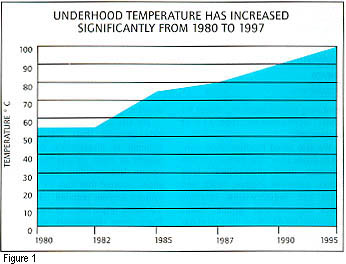
Figure 1 demonstrates the rise in temperature under the hood to
in excess of 90¡ C in many cases. The battery industry has
always been painfully aware of the impact of temperature on the
life of the battery. Figure 2 illustrates a junk bin
study made by an independent third party for Delphi and AC Delco
comparing Delphi batteries to the competition. Comparing life
in different climactic regions illustrates the impact of temperature
on the life of the battery.
The degree of increased application temperatures has mitigated
past durability improvements to the extent that no technology
has head and shoulders superiority when it comes to high operating
temperature durability. Warranty experience after three years
shows that very hot applications can have as much as 600% greater
warranty than applications that meet the 52¡ C maximum continuous
operating temperature recommended by Delphi.
Car manufacturers at first seemed oblivious to the impact of temperature
on the life of the battery, but high warranty cost has made them
more aware. Heat shielding has become a fairly common requirement
for the battery. Improvements to positive grid alloys – increased
tin in wrought calcium lead and the addition of silver to cast
calcium lead – will extend the life of batteries in hot climates
beyond that shown in Figure 2.
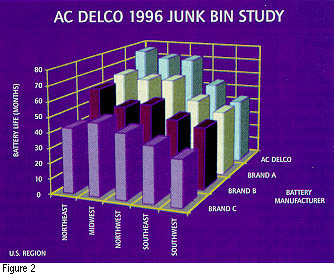
Three- and even four-year warranty policies on batteries have
been put in place by automotive companies. Warranty policies are
primarily a marketing issue and sometimes were made without a
good understanding of battery life and the impact of temperature
on battery life. These warranties have made the durability of
batteries a more important requirement.
Battery role and requirements
A historical review of automotive battery requirements has shown
that the role of the battery in internal combustion powered automobiles
has always been that of an enabling technology. These requirements
were found to be the results of the needs of:
- the electrical system;
- the vehicle’s design; and
- marketing.
These needs will continue to influence future requirements and
will continue to be the result of a need to make something else
possible. Typically, the requirements for automotive batteries
came from electrical system needs, e.g., power for cranking motors;
from vehicle design needs, e.g., lower height to allow lower hood
lines; and from marketing needs, e.g., maintenance free technology
to make the battery transparent to the car owner.
There is, however, one easily identifiable emerging source of
future requirements, i.e., the global nature of the automotive
business. Automotive companies are building products globally,
based on the same basic platform design. Their desire is to have
the basic components, such as the battery, for these platforms
the same anywhere they build in the world.
There are three primary sources for future automotive requirements.
These sources are:
- market based;
- vehicle design based; and
- electrical system based.
Marketing requirements will include:
- maintaining transparency, quality, reliability and life; and
- providing a safe engine start under any conditions, including
run-down protection, protected start, and "smart" batteries.
The ability to market the total car as problem/maintenance free
for longer and longer times has forced the inclusion of the battery
into that guarantee. Cars being advertised today are promoted
as needing no major tune-ups until 100,000 miles of service. Batteries
will need to have a minimum life of five years in all regions
of the country to meet this type of expectation and to keep warranty
costs down.
While starting failures due to run-down batteries continue to
be the major battery related consumer complaint, as well as the
highest battery related warranty claim item, I would not expect
that a requirement of future batteries would be to fix this problem.
This is an electrical system problem and will be solved as a systems
solution.
Even relatively simple run-down protection approaches such as
the one shown in Figure 3 that times out short term
and long term loads, have been demonstrated to significantly impact
the incidence of warranty claims due to run-down batteries.
The marketing desire to satisfy and protect the customer from
the inconvenience of a "no start" due to a run-down
or worn out battery could lead to the requirement of a "smart"
battery. The combination of the computational power of automotive
computers and algorithms that accurately define battery state
of charge and state of health could meet this requirement.
Vehicle design requirements will include:
- Function in the engine compartment, i.e., elevated temperature
durability; packaging, i.e., minimum mass and minimum volume;
design for assembly; and integration of ancillary parts, i.e.,
tray, heat shield, etc.
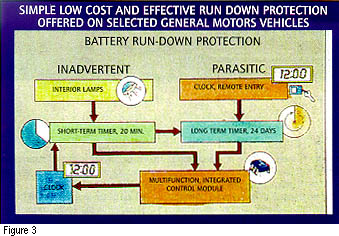
A major vehicle design-based requirement will continue to be for
the battery to be packaged close to the cranking motor to keep
costs down. The battery will need to operate at underhood temperatures.
Underhood temperatures are not expected to go much beyond those
discussed earlier, but it is also expected that there will not
be significant decreases in temperatures.
If grid alloy improvements are able to extend battery life, the
loss of water in extreme high operating temperature applications
may become the life limiting failure mode for flooded batteries.
The mass of the battery has become an important requirement and
will become a more important requirement in the future. This requirement
will be driven by the need for fuel economy and the ability of
vehicles to be designed to make desired EPA weight classes.
Automotive engineers typically define the value of reduced weight
to be $1 to $2 per pound weight reduction. One manufacturer has
recently set performance and mass requirements that preclude a
solution with a single battery designed with current, flooded
lead acid technology.
Packaging the battery under the hood continues to be a challenge.
The space and system cost constraints allowed for the power and
energy function may also preclude the application of a single
battery designed with today’s flooded lead acid technology.
Mass and volume requirements could dictate a two-battery requirement;
one battery designed for maximum power to provide the power for
cranking, and the other designed for capacity and cycling capability
to meet running load demands. Both batteries and ancillary equipment
would need to be designed to minimize weight and cost.
Assembly of the battery into the vehicle has begun to establish
requirements for batteries. Most batteries are placed in position
with either a robot or a mechanical assist for the assembler.
These operations require physical features on the battery to allow
it to be picked up by these devices.
In line with lean manufacturing concepts and design for assembly
concepts, batteries may have requirements for improved assembly
into the automobile with no tools, or standardized, simple tools.
Ancillary parts for the automotive battery, i.e., tray, heat shield
and terminal connections, may be supplied along with the battery
in the form of a system. The purpose being to reduce automobile
assembly cost and complexity.
Vehicle electrical systems
The primary source of requirements for the automotive battery
has always been the electrical system. Any change from the current
12 volt system will generate new requirements for the battery.
After the introduction of the starting motor, the design of the
automotive electrical system was established by two requirements:
1) Provide power to start the engine; and 2) Provide power to
electrical loads during operation of the vehicle.
Modern electronics has added a third requirement – provide power
for "key off" loads such as digital clocks, computer
memory, etc. Future automotive battery requirements will be, to
a large extent, derived from changes in these three electrical
system requirements. I see no significant changes in "key
off" loads coming in the future. Automotive manufacturers
implement designs to minimize these parasitic loads.
The trend in engine technology is to make engines more powerful
and efficient and with lower emissions. Engine technology trends
should not make engines harder to start. Reduction in engine parts
friction and improved understanding of the events required to
start an engine have, to some extent, lowered the electrical power
required to start engines.
Major shifts in power requirements to start engines do not appear
to be on the horizon. Starter motor technology does not seem to
have any major changes being forecast that would impact the power
requirements for the automotive battery.
There are, though, two technology developments in progress that
could eliminate the need for the high power requirement for automotive
batteries. The first is the ultracapacitor. An ultracapacitor
can be used to supply starter current. An automotive electrical
system designed with an ultracapacitor would require much lower
current from the battery. The battery could then be designed accordingly.
The second development in engine technology might even eliminate
the need for a starter motor. Engines are moving towards direct
fuel injection to improve fuel economy and emissions. Electromechanical
valve control is being developed to improve engine performance
and cost.
In the future, engine valves could be electromechanically actuated
as opposed to the mechanical actuation of today’s engines. In
theory, direct fuel injection and electromechanically controlled
valves may be able to start an engine statically, with no initial
rotation of the engine required. This would eliminate the high
power battery requirement.
The electromechanically actuated valve is an example of the type
of new electrical load that could lead to major changes in the
design of the automotive electrical system. For a six cylinder
engine, a peak power of 2400 watts is required to service this
lead; the average power required is 800 watts.
The demand for electrical power in future automobiles continues
to grow. Figure 4 shows the historical growth and the
forecasted growth of automobile electrical power requirements
as expressed by the instantaneous power capability of the generator.
This exponential forecast rate of growth is the result of two
driving forces on the electrical system – the need for improved
fuel economy, and the potential new power-hungry automotive functions.
To improve fuel economy, many devices now driven directly by the
engine can be more efficiently driven electrically. Some of these
potential future electrical loads are shown in Figure 4.
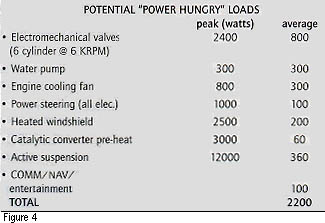
It should be noted that most of these loads can be operated more
efficiently at voltages higher than the current 12 volt system
voltage used in today’s automobiles. The bottom line is that in
the future more electrical system power will be needed. But, that
power must be used very efficiently.
Additional power can be obtained by increasing the alternator’s
capacity and/or the battery augmenting the alternator’s output.
On a car with high electrical content, it is not uncommon to have
a two kilowatt output alternator. The limits of belt driven, air
cooled, Lundel type alternators has about been reached at two
kilowatts.
Future alternators might achieve higher output at idle speeds,
but increased peak output will depend on the development of new
types of machines driven by means other than belts. In effect,
additional power can be obtained if the power available is used
more efficiently.
Energy management systems for future automobiles are a way to
more effectively utilize available power. These systems can include:
allowing the charge voltage to float when the battery is at a
high enough state of charge; pump energy into the battery when
the car is decelerating; increase charging when engine power is
available and the battery can accept charge; increase idle speed
if battery state of charge is low; if battery state of charge
is low shed non critical loads; and protected start capability.
The computers on board automobiles today have the control capability
that will be required by future energy management systems. However,
the technology that is needed to make energy management systems
effective is a "smart" battery. In this case, a "smart
battery" would be one that could keep the energy management
system apprised of its state of charge, its temperature and its
capability for accepting charge.
Higher system voltage improves the efficiency of many of the new
electrical devices and of the automotive system in general by
reducing resistive losses by lower required current.
To achieve this improved efficiency, the system voltage must be
significantly higher than 12 volts, but for safety reasons, less
than 50 volts. The industry increased system voltage in the mid
1950s. Why not again in the future?
The automotive electrical system is much more complex than it
was in the 1950s. The infrastructure around 12 volt system components
is large and complex. Small, economy vehicles will not utilize
many of the new electrical loads. For these reasons, it is unlikely
that the automotive electrical system voltage will be raised to
one, higher level voltage across the industry.
In sum, using electrical power more efficiently is characterized
by the following: voltages much higher than 12 volts (50 volts
or less for safety) will be required; there are too many difficulties
for all automotive electrical devices to be moved to one higher
operating voltage; any future electrical system will be multiple
voltages, most likely a dual voltage system such as 12-24 volts,
12-36 volts or 12-48 volts; and power electronics will be the
enabling technology that makes dual voltage systems viable.
The alternative is to return to a multiple voltage system like
Kettering’s electrical system design which was a dual voltage
system. At this time, the most likely system would be a dual voltage
one. Systems that are 12-24 volts, 12-36 volts and 12-48 volts
have been explored.
A dual voltage system is not a new approach; many heavy duty truck
and off road equipment electrical systems are dual 12-24, voltage
systems as the illustration from a 1957 Delco Remy training manual
in Figure 5 shows. In this system, and in Kettering’s
system, the higher voltage was required for the cranking motor.
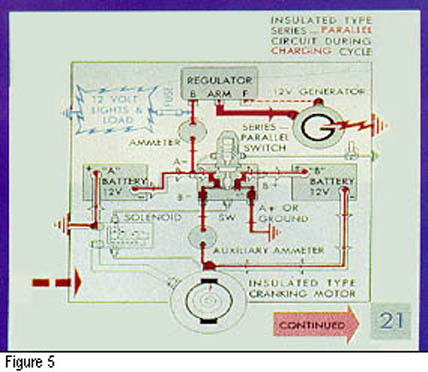
In future automotive electrical systems, a voltage greater than
12 volts will be required for many loads to operate efficiently,
and to reduce the amount of copper needed to transmit power to
loads. The multiple voltage system will be much more complex than
this dual voltage one.
There have been many studies and proposed designs on potential
multiple voltage systems over the past 10 to 15 years. Proposed
designs have ranged from dual DC voltage levels to ones that would
envision low level DC voltages and higher level AC voltages. My
intent is not to establish the type and design of a new multiple
voltage electrical system, but to assess the probability of such
systems and the requirements such systems will impose on the battery.
If the potential for improving fuel economy by utilizing electrical
energy in place of mechanical energy is to become a reality, the
enabling technology will power electronics, not batteries. The
efficient conversion of electrical energy to different voltage
levels is a rapidly developing technology that has the potential
for continuing cost reduction.
New multiple, high voltage automotive electrical systems will
require cost effective power electronics to become viable. Higher
voltage electrical systems using power electronic converters can
be conceptualized using a 12 volt battery as the energy storage
device.
In theory, new battery technology would not be required to make
these multiple, high voltage electrical systems possible, but
power electronics is. However, a higher voltage battery would
make the task easier and is still very desirable.
In light of this information, what would one conclude the automotive
storage battery beyond the year 2000 will be? The battery will
need to have a minimum life of five years even while being located
in the engine compartment, and it must apply in all regions of
our country.
To achieve this type of life, the battery will be required to
be durable at high operating temperatures and to have good life
while being load cycled. The battery will need higher energy density
both volumetric and gravimetric to reduce weight and to make packing
easier.
The battery needs to supply a higher voltage than the current
12 volts, probably at least 36 volts. The battery needs to be
able to provide information about itself, e.g., state of charge
and state of life. The manufactured quality of the battery and
the battery’s reliability must continually improve. For those
of us working to satisfy the needs of the original equipment market,
it will be an interesting and challenging next 10 to 15 years
as the automotive industry comes to terms with fuel economy and
clean air requirements.
If I had given this presentation in 1987, it would have been very
much the same as what I presented here. In the year, 2007, however,
I believe it will be a new presentation – a story of dramatic
changes or planned changes in the automotive electrical systems
and the battery to provide that system’s stored energy requirements.
Doug Barron is manager of the Freedom Battery Design &
Application, Delphi Energy & Engine Management Systems, 8750
Hague Rd., P.O. Box 502650, Indianapolis, IN 466250.













